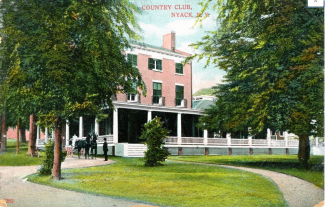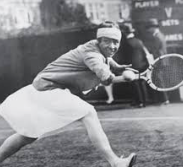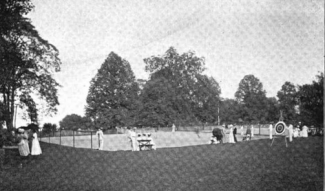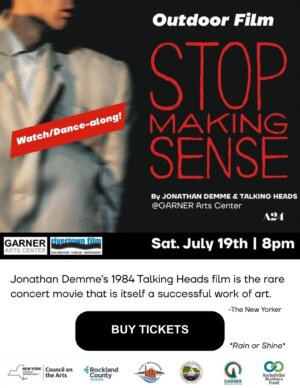by Mike Hays

Colorized postcard of the Nyack Country dated 1906 but the photo is probably somewhat earlier. Courtesy of the Nyack Library.
Summertime and the livin’ was easy at the Nyack Country Club from 1890-1917. Stretching from N. Broadway to N Midland Ave, the clubhouse was located where the Upper Nyack Elementary School now stands. A list of Gilded Age entertainments offered by the club is lengthy. Tennis on four clay courts. Archery. A 9-hole golf course. A large baseball diamond. Horse shows. Billiards tournaments featuring the American professional champion. Saturday afternoon tea on the lawn. Cards. Outdoor performances of Shakespeare. Evening dances with sidewalks lit by a thousand fairy lamps and scores of Japanese lanterns hung around the three-story brick colonial club house. A restaurant with, at one time, a French chef and French cuisine. No wonder the club was the center of social life in Nyack for summer residents and wealthier full-year residents.
The club was often mentioned in the New York media for its tennis tournaments and social events. Names of attendees read like a social register of what newspapers called the “well-known.” Open from May 1 to November 1, people arrived by horse and carriage on a circular drive amid broad lawns beneath beautiful shade trees. The club’s moment in the sun was not long. The advent of automobiles coupled with WWI changed American culture forever. The story of the Nyack Country Club shines a bright light on a world that most who lived in Nyack knew nothing about. The story begins before 1890 and ends at the close of WWI.
Maxwell House

Locally produced postcard circa 1908. Courtesy of the Nyack Library.
The three-story brick clubhouse with porches and verandas was built around 1838 by Hugh Maxwell, a famous New York City District Attorney and Collector of the Port of New York. Maxwell’s 100-acre estate was the first by wealthy New Yorkers who swooped in to buy old Nyack farms for summer homes. Maxwell replaced a pre-Revolutionary War stone house. Maxwell’s enjoyed his summer home during his retirement, setting the tone for its later form as a place of leisure.
Maxwell died in 1873 but his will was so complex that the executors couldn’t figure it out. For example, his will stated that his son, one of six children, would hold the land until his grandchildren came of age and then they would inherit, causing no end of confusion as to the actual ownership. The matter wasn’t resolved for over 25 years until it was decided by a suit of partition in the New York State Supreme Court. In the meantime, it was used as boarding house run by the no-nonsense pair, Mrs. Powell and Miss Cochran.

Photo of clubhouse and courts in winter. Courtesy of the Nyack Library.
In 1890 the newly formed Nyack Country Club purchased or leased the house and property from the estate referees. In 1902, the entire former-Maxwell property excepting the riverside portion east of Broadway was bought by Van Wyck Rossiter, President of the Rockland County Trust Company. Rossiter lived on the property part-time, was a member of the club, and built a half-timbered Tudor estate on the Midland Ave. side of the property. Today, the Rossiter home is the Nyack Field Club. Although not stated, the Nyack Country Club must have leased the property from Rossiter on favorable terms. When Rossiter died at age 49 in 1919, the property went up for sale.
Grand Opening

A cotillion from the 1890s.
The club held a grand opening in its renovated clubhouse in June 1891. The interior was typically Victorian, with wood floors and antique oak furniture highlighted by palm trees. The color scheme was based on the club colors of gold and white. The first-floor reception walls were hung with over 30 engravings by Charles Frederick William Mielatz, a well-known New York artist of the time. The artist may have been recommended by a noteworthy Nyack artist and club member, Julian O. Davidson, who surely knew Melitz as a member of the New York Etching Society. A 35 x 50-foot casino was added to the north end to provide more space for dancing, theatrical performances, and other entertainment.
The house was magnificent. The robin’s egg blue-colored music room was next to the reception room, and it contained an antique oak piano. A kitchen and terra cotta-decorated dining room completed the first floor. The second floor had pool and billiard rooms, four card rooms, and a women’s dressing room. The third floor had four dressing rooms for men. The house was lit by electricity with golden-hued globes, electricity being a new phenomenon in Upper Nyack.
The opening lasted all day with a party at night. Gentlemen wore full evening garb and women wore elegant dresses. The supper was furnished and served by women of the club. Music was provided by Prof. Rosenkranz of New York City.
Membership

1890s tennis player.
Unlike many clubs, women could be members, however, according to the bylaws, the only committees they could serve on was entertainment. The committee was composed entirely of women. Life members paid an initiation fee of $240 in 1915, about $6.5K in today’s currency. Women paid $80. Active yearly dues were $30 for men and $30 a year for such women as had the right to vote, that number being zero until 1919. Tips were not allowed at the club.
Club members had first rights to the bedrooms before visitors. Members could not make any comment to the media. Junior members could not use the courts on Sunday and had to give way to regular members at other times.
There is no mention of Black membership, it would have been unthinkable at the time, although the wait staff might have been.
Tennis Anyone?

Lithograph of lawn tennis in 1887.
Tennis was a new and trendy sport during the Gilded Age. The United States National Lawn Tennis Association (now the United States Tennis Association)was newly formed in 1881. The clubs 4 clay courts along Broadway were above average with wind breaks and sanctioned by the USNLTA. The stands were usually filled to watch regularly scheduled tournaments. The driving force behind club tennis was Augusta Bradley Chapman who was listed among the top ten ranking tennis players in America. Partly because Chapman was known to many, women tennis stars were attracted to play at the Nyack Country Club tournaments, more so than men. The most famous was Norwegian Molla Bjursted Mallory who won the U.S. championship six times. She is remembered as a women’s rights supporter who hung out at the club drinking and smoking cigarettes. A former president of the USNLTA said, “She walked around in a manner that said, ‘You’d better look out or she’d deck you.’ She was an indomitable scrambler and runner. She was a fighter.” An exhibition match between Chapman and Mallory drew a huge crowd.

Women tennis players at the turn of the century.

Tennis champion Mallory.
Members of the King’s County Tennis Club in Brooklyn and the predecessor to the Forest Hill, Long Island Club, then at Columba University, took part in the tournaments, which were open to all players. Tournament results were reported in the New York Times. On September 7, 1894, the Times reported that Jack Talmedge of Yale, a former champion, was off his game having just returned from Europe. J. P. Paret played a “cool, skillful game” and beat the champ. Chapman lost the finals in four sets (women winners needed three sets to win then) and went on to lose in mixed doubles.
Outside of tournaments, the courts were in constant use especially on Saturday and Sunday mornings. Tennis on Sunday became a club controversy, tennis devotees eventually winning out over church goers. On Friday, commuters would race home arriving on the 5:45p train, change clothes, and bike to the club to play tennis until dusk.
Golf, Billiards, & Horses

Postcard showing tennis courts and an archery range (look out). The courts appear to be on the upper part of the club not on Broadway. Courtesy of the Nyack Library.
The nine-hole golf course attracted golfers until the larger and better Rockland Country Club was built in nearby Sparkill. Billiards was played in the club house on regular weekday nights. Wilson Foss, Upper Nyack quarry owner and a national amateur billiards champion, played at the club. DuPratt White, who built a new home across the street that is now the Summit School, was a regular billiards player. According to Virginia Parkhurst, noted local reporter and historian, “a successful horse show” was held on the open fields along Midland Ave. probably gaining impetus from horse afficionado Van Wyck Rossiter. An annual show continued for several years thereafter. Archery was also practiced by women club members.
Cotillions, Cards, Plays, & More

Victorian lawn party with stage.
Saturday night and special occasion dances were popular events. One example among many occurred on an August 1892 evening with carriage after carriage arriving between 9p and 10p. Fairy lamps and Japanese lanterns adorned the lawns and veranda. Inside, potted ferns filled fireplaces and the ceiling was trimmed with goldenrod. Dancing began at 10p. Music floated outside to the welcoming verandas and lawn.
At midnight a dinner, prepared by Favier, the club chef, was served. Delightful promenades followed supper, and dancing continued until 2:30a. Guests left with party favors, silver coffee spoons for the women engraved with N.C.C. and hatbands for the men with individual names of each.
Early in the summer, the Coburn Shakespeare Players would stage Shakespeare comedies on the lawn along with the balcony scene from Romeo and Juliet. Plays were often held for charity. A regular event was the outdoor staging of the Rivals by George Ober and company with benefits going to the Nyack Hospital. Local actors performed in numerous plays including The Bachelor’s Reverie performed by twenty local women.

A formal dinner party.
Card parties were a regular event as well and often written up in the local newspaper. In June of 1903, Mrs. Carscallen, who lived in the nearby estate, Birchwood, hosted a ten-table game of whist and bridge. Prizes were awarded, dinner was served at 11p, and a short dance followed.
Women only events were common. About 50 women attended the first of the “Musical Mornings” series held on Wednesday mornings in 1895 in the casino. Music was played by local women. A dance followed. On Saturday, afternoon tea was served on the lawns.
Among the odder charity events was a tennis tournament held before an evening of dance by six men dressed as women with young female referees. One of the most sober legal minds in New York State, DuPratt White, played while dressed as a Grecian girl.
End Of An Era

1915 was an era of transition as shown here in this magazine cover.
The Gilded Age glory of the Nyack Country Club changed in a single decade. Nyack’s first locally owned automobile appeared in 1908. Soon people were able to travel further for a night out. The 1907 opening of the Rockland Country Club drew away the golfers. WWI meant there were fewer young men. The Board of Directors voted to close the club at its current location in1917, join with the Nyack Art Club to form the Nyack Club and relocate to the aging Tappan Zee House in S. Nyack.
With Rossiter’s death in 1919, the property was sold to, of all people, the Great OOM, Pierre Bernard, his first purchase in the Nyacks. That is an interesting story but for another time.
The gracious era of the Nyack Country Club––the horse and carriage days, tea on the lawn, tennis tournaments, and the gatherings of the elite to dance and play cards in the evening––was lost forever. The era of automobiles and the advent of WWI ripped the old social fabric. Nyack was no longer an isolated village, but a community in a fast-globalizing world.
Michael Hays is a 35-year resident of the Nyacks. He grew up the son of a professor and nurse in Champaign, Illinois. He has recently retired from a long career in educational publishing with Prentice-Hall and McGraw-Hill. He is an avid cyclist, amateur historian and photographer, gardener, and dog walker. He has enjoyed more years than he cares to count with his beautiful companion, Bernie Richey. You can follow him on Instagram as UpperNyackMike.

 Nyack People & Places, a weekly series that features photos and profiles of citizens and scenes near Nyack, NY, is brought to you by Sun River Health, and Weld Realty.
Nyack People & Places, a weekly series that features photos and profiles of citizens and scenes near Nyack, NY, is brought to you by Sun River Health, and Weld Realty.







